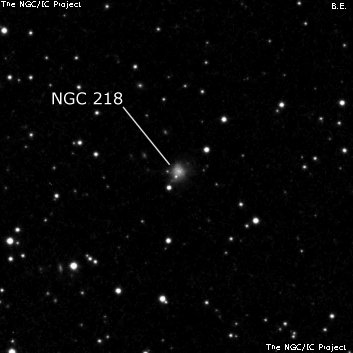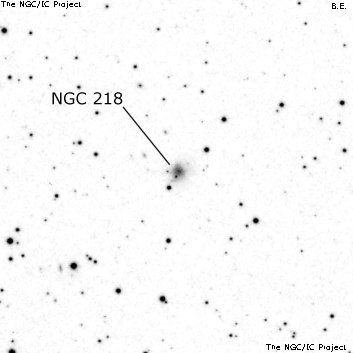NGC/IC Project Restoration Effort
(This is a very very beta version)
NGC218


Basic Information
Location and Magnitude
Right Ascension: 0:46:32.0
Declination: +36:19:32
Constellation: AND
Visual Magnitude: 12.6
Historic Information
Discoverer: Stephan
Year of discovery: 1876
Discovery aperture: 31.0
Observational
Summary description: eF, vS, R, gbM
Sub-type: Sc
Corwin's Notes
=====
NGC 218. Steve Gottlieb found that Esmiol has listed this discovery of
Stephan's with a different RA offset. Once the correction is made, Stephan's
offsets point exactly to UGC 480, the brighter of an interacting pair (VV 527).
UGC 440, the galaxy that we all previously took to be NGC 218, is not only not
at Stephan's offsets (even the wrong ones), but is nearly two magnitudes
fainter than UGC 480. Steve has finally found the correct galaxy.
Stephan found nine galaxies that Esmiol listed as "Anonyme" (without NGC
number); six have turned out to be NGC objects, while three did not make it
into the catalogue. See the discussions under UGC 3840 in the "notngc" files
for more on Stephan's observations of these galaxies.
Steve's Notes
=====
NGC 218
24" (12/22/14): moderately bright and large, irregularly round, ~0.8' diameter though the halo increases in size and shape with averted vision. A brighter nucleus is offset to the east side of the galaxy, so could be mistaken for a knot in the halo. Forms an interacting pair with CGCG 519-022 1.4' ENE.
CGCG 519-022 is fairly faint, fairly small, slightly elongated N-S, 0.4'x0.2', very weak concentration. The SDSS reveals numerous thin, blue arm segments of NGC 218 that are apparently tidally stretched towards CGCG 519-022.
17.5" (9/1/02): fairly faint, fairly small, irregular shape and surface brightness, 1.0' diameter, broadly concentrated. Forms the right angle of a small isosceles triangle with two mag 13.5-14 stars 1.4' N and 1.3' W. Forms an interacting pair with MCG +06-02-017 1.4' E. The companion is very faint, small, elongated 2:1 N-S, 0.5'x0.25'. Member of the Pisces-Perseus Supercluster.



